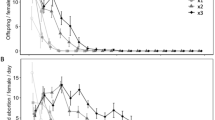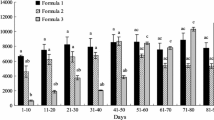Abstract
Laboratory trials were undertaken to investigate the nutrition ofBracon brevicornis Wesmael adults on: (1) artificial diets (sucrose, treacle, honey bee and tap water); (2)Sesamia larvae (exposed under 3 manipulations); (3) 5 host species (Galleria, Ephestia, Sesamia, Spodoptera andOstrinia); in addition to starvation at 12, 15, 20, 25, 30, 35 and 40°C. Among artificial diets, honey bee solution was the most suitable that prolonged significantly each sex to be more than 1 month at 25°C.A Bracon female supplied daily with a freshSesamia-larva was significantly longer-lived than when kept with the “unchanged”Sesamia-larva. Larvae of borers (Sesamia andOstrinia), gave significantly the highest longevity for females among other host species. Adult-longevity was significantly decreased with an increase in temperature.
Females were significantly longer-lived than males when kept only with living host insects. However, such sex difference was generally uncertain when either was supplied with an artificial diet or starved under temperatures ranging from 12–40°C.
Résumé
Des expériences en laboratoire ont été réalisées pour étudier la nutrition des adultes deBracon brevicornis Wesmael sur: (1) des milieux artificiels (sucrose, mélasse, miel et eau du robinet), (2) des chenilles de sésamie (présentées de 3 façons, (3) 5 espèces d'hôtes (Galleria, Ephestia, Sesamia, Spodoptera etOstrinia) et aussi soumis au jeûne, à 12, 15, 20, 25, 30, 35 et 40°C.
Parmi les aliments artificiels, l'eau miellée est le meilleur, car elle augmente la longévité des 2 sexes de plus d'un mois à 25°C. La femelle deBracon pourvue chaque jour d'une larve de sésamie vit significativement plus longtemps qu'en présence de la même chenille. Avec les chenilles des foreurs (Sesamia etOstrinia) on obtient la longévité des femelles la plus élevée parmi toutes les autres espèces-hôtes. L'augmentation de la température diminue la longévité de manière significative.
Les femelles vivent plus longtemps que les mâles en présence seulement d'insectes hôtes vivants. Cependant cette différence est généralement moins nette lorsque lesBracon sont nourris avec un aliment artificiel ou laissés à jeûn à des températures allant de 12 à 40°C.
Similar content being viewed by others
References
DeBach, P. (ed.) — 1965. Biological Control of Insect Pests and Weeds. —Reinhold N.Y.
Hafez, M. — 1972. Certains factors influencing mortality of natural enemies of cotton pests. —Agric. Res. Rev., Cairo, 50, 1–16.
Mathews, R.W. — 1974. Biology ofBraconidae. —Annu. Rev. Entomol., 19, 15–32.
McKnight, M.E. — 1971. Biology and habits ofBracon politiventris [Hymenoptera: Braconidae] —Ann. Entomol. Soc. Am., 64, 620–664.
Stehr, F.W. — 1975. Parasitoids and predators in pest management. In: Introduction to Insect Pest Management (R.L. Metcalf, W.H. Luckman: eds). —John Wiley & Sons, N.Y., 587 p.
Temerak, S.A.— 1976. Studies on certain mortality factors affecting distribution and abundance of sugarcane borers in upper Egypt.—Ph.D. Thesis, Coll. of Agric. Assiut Univ., Egypt.
Temerak, S.A. — 1981. Differential response and suitability of the hibernating and active larvae ofSesamia cretica to the development of the parasitoid,Bracon brevicornis. —Anz. Schad. Pflanz. Um., 54, 149–151.
Temerak, S.A. — 1982. Effect of different constant temperatures on certain biological aspects ofBracon brevicornis Wesmael, a larval ectoparasitoid ofSesamia cretica Led. —Bull. Soc. Entomol. Egypte.
Temerak, S.A., Abdel-Galil, F.A. & Morsy, M.A.A. — 1982. Time required for the development of the braconid,Bracon brevicornis WEsmael onGalleria mellonella (Linnaeus) larvae at different constant temperatures. —Assiut J. Agric. Sci.
Author information
Authors and Affiliations
Rights and permissions
About this article
Cite this article
Temerak, S.A. Longevity ofBracon brevicornis [Hym: Braconidae] adults as influenced by nourishment on artificial and natural foods. Entomophaga 28, 145–150 (1983). https://doi.org/10.1007/BF02372138
Issue Date:
DOI: https://doi.org/10.1007/BF02372138




